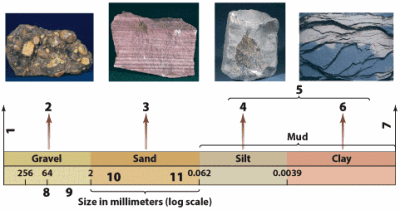Classification Of Rocks By grain Or Crystal Size – Geology Notes – For W.B.C.S. Examination.
শস্য বা স্ফটিক আকারের দ্বারা শিলাগুলির শ্রেণিবদ্ধকরণ – ভূতত্ব নোট – WBCS পরীক্ষা।
For sedimentary rocks, the broad categories of sediment size are coarse (greater than 2 millimetres, or 0.08 inch), medium (between 2 and 1/16 millimetres), and fine (under 1/16 millimetre). The latter includes silt and clay, which both have a size indistinguishable by the human eye and are also termed dust. Most shales (the lithified version of clay) contain some silt. Pyroclastic rocks are those formed from clastic (from the Greek word for broken) material ejected from volcanoes. Blocks are fragments broken from solid rock, while bombs are molten when ejected.
Porosity
The term rock refers to the bulk volume of the material, including the grains or crystals as well as the contained void space. The volumetric portion of bulk rock that is not occupied by grains, crystals, or natural cementing material is termed porosity. That is to say, porosity is the ratio of void volume to the bulk volume (grains plus void space). This void space consists of pore space between grains or crystals, in addition to crack space. In sedimentary rocks, the amount of pore space depends on the degree of compaction of the sediment (with compaction generally increasing with depth of burial), on the packing arrangement and shape of grains, on the amount of cementation, and on the degree of sorting. Typical cements are siliceous, calcareous or carbonate, or iron-bearing minerals.
Sorting is the tendency of sedimentary rocks to have grains that are similarly sized—i.e., to have a narrow range of sizes (see ). Poorly sorted sediment displays a wide range of grain sizes and hence has decreased porosity. Well-sorted indicates a grain size distribution that is fairly uniform. Depending on the type of close-packing of the grains, porosity can be substantial. It should be noted that in engineering usage—e.g., geotechnical or civil engineering—the terminology is phrased oppositely and is referred to as grading. A well-graded sediment is a (geologically) poorly sorted one, and a poorly graded sediment is a well-sorted one.
Total porosity encompasses all the void space, including those pores that are interconnected to the surface of the sample as well as those that are sealed off by natural cement or other obstructions. Thus the total porosity (ϕT) is

where VolG is the volume of grains (and cement, if any) and VolB is the total bulk volume. Alternatively, one can calculate ϕT from the measured densities of the bulk rock and of the (mono)mineralic constituent. Thus,

where ρB is the density of the bulk rock and ρG is the density of the grains (i.e., the mineral, if the composition is monomineralogic and homogeneous). For example, if a sandstone has a ρB of 2.38 grams per cubic centimetre (g/cm3) and is composed of quartz (SiO2) grains having ρG of 2.65 g/cm3, the total porosity is

Apparent (effective, or net) porosity is the proportion of void space that excludes the sealed-off pores. It thus measures the pore volume that is effectively interconnected and accessible to the surface of the sample, which is important when considering the storage and movement of subsurface fluids such as petroleum, groundwater, or contaminated fluids.
Please subscribe here to get all future updates on this post/page/category/website


 +919674493673
+919674493673  mailus@wbcsmadeeasy.in
mailus@wbcsmadeeasy.in







































































































